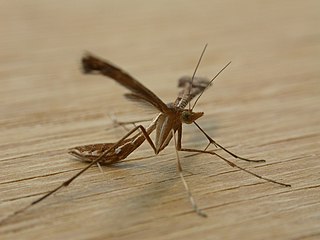
The Pterophoridae or plume moths are a family of Lepidoptera with unusually modified wings, giving them the shape of a narrow winged airplane. Though they belong to the Apoditrysia like the larger moths and the butterflies, unlike these they are tiny and were formerly included among the assemblage called "microlepidoptera".

Platyptilia gonodactyla, also known as the triangle plume, is a moth of the family Pterophoridae found in temperate Asia and Europe. It was first described by the Austrian entomologists, Michael Denis & Ignaz Schiffermüller in 1775.

Sinpunctiptilia emissalis is a moth of the family Pterophoridae. It is found in Australia, including Tasmania.

Platyptilia celidotus is a species of moth in the family Pterophoroidea. This species was described by Edward Meyrick in 1885 and named Lioptilus celidotus. It has been found in both New Zealand and Australia.

Platyptilia is a genus of moths in the family Pterophoridae. The genus was described by Jacob Hübner in 1825.

Platyptilia isodactylus is a moth of the family Pterophoridae found in China, Europe and was introduced to Australia and New Zealand for biological control. It was first described by the German entomologists, Philipp Christoph Zeller in 1852.

Platyptilia farfarellus is a moth of the family Pterophoridae. The species was described by Philipp Christoph Zeller in 1867. It is found from central and southern Europe to Asia Minor, Micronesia and Japan. It is also known from Africa, where it has been recorded from Equatorial Guinea, Kenya, Madagascar, Mauritius, Nigeria, South Africa, São Tomé & Principe, Tanzania, Uganda, the Seychelles and Malawi.
Platyptilia gentiliae is a moth of the family Pterophoridae. It is known from Argentina and Chile.
Platyptilia davisi is a moth of the family Pterophoridae. It is known from Chile.
Platyptilia vilema is a moth of the family Pterophoridae. It is known from the Galápagos Islands.
Platyptilia semnopis is a moth of the family Pterophoridae. It is known from Brazil.
Platyptilia gravior is a moth of the family Pterophoridae. It is known from Costa Rica.
Platyptilia anniei is a moth of the family Pterophoridae. It is known from Bolivia, Ecuador, Peru and Venezuela.
Platyptilia molopias is a moth of the family Pterophoridae. It has a very wide distribution in the Old World tropics, ranging from Africa through India and Sri Lanka, east to Indonesia. It is also found in the Philippines on Luzon, Mindoro, Negros and Mindanao.
Platyptilia williamsii is a moth of the family Pterophoridae. It is known from western North America, including California.
Platyptilia phanerozona is a moth of the family Pterophoridae. It is known from New Guinea.
Platyptilia archimedon is a species of moth from the family Pterophoridae. It is known from New Guinea.
Platyptilia enargota is a moth of the family Pterophoridae. It is known from Borneo and New Guinea.

Platyptilia campsiptera is a species of moth in the family Pterophoridae. This species is endemic to New Zealand. This species has been classified as Nationally Vulnerable by the Department of Conservation.
Epiphyas caryotis is a species of moth of the family Tortricidae. It is found in Australia, where it has been recorded from Victoria, the Australian Capital Territory and Tasmania. The habitat consists of montane rainforests and wet eucalypt forests.
This page is based on this
Wikipedia article Text is available under the
CC BY-SA 4.0 license; additional terms may apply.
Images, videos and audio are available under their respective licenses.







